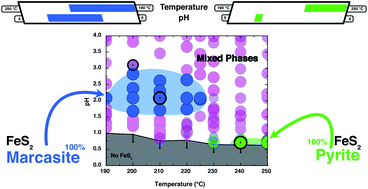Synthetic control over polymorph formation in the d-band semiconductor system FeS2

Pyrite, also known as fool’s gold is the thermodynamic stable polymorph of FeS2. It is widely considered as a promising d-band semiconductor for various applications due to its intriguing physical properties. Marcasite is the other naturally occurring polymorph of FeS2. Measurements on natural crystals have shown that it has similarly promising electronic, mechanical, and optical properties as pyrite. However, it has been only scarcely investigated so far, because the laboratory-based synthesis of phase-pure samples or high quality marcasite single crystal has been a challenge until now. Here, we report the targeted phase formation via hydrothermal synthesis of marcasite and pyrite. The formation condition and phase purity of the FeS2 polymorphs are systematically studied in the form of a comprehensive synthesis map. We, furthermore, report on a detailed analysis of marcasite single crystal growth by a space-separated hydrothermal synthesis. We observe that single phase product of marcasite forms only on the surface under the involvement of H2S and sulphur vapor. The availability of high-quality crystals of marcasite allows us to measure the fundamental physical properties, including an allowed direct optical bandgap of 0.76 eV, temperature independent diamagnetism, an electronic transport gap of 0.11 eV, and a room-temperature carrier concentration of 4.14 × 1018 cm−3. X-ray absorption/emission spectroscopy are employed to measure the band gap of the two FeS2 phases. We find marcasite has a band gap of 0.73 eV, while pyrite has a band gap of 0.87 eV. Our results indicate that marcasite – that is now synthetically available in a straightforward fashion – is as equally promising as pyrite as candidate for various semiconductor applications based on earth abundant elements.
KeYuan Ma, Robin Lefèvre, Qingtian Li, Jorge Lago, Olivier Blacque and Fabian O. von Rohr
Chem. Sci., 2021, 12, 13870